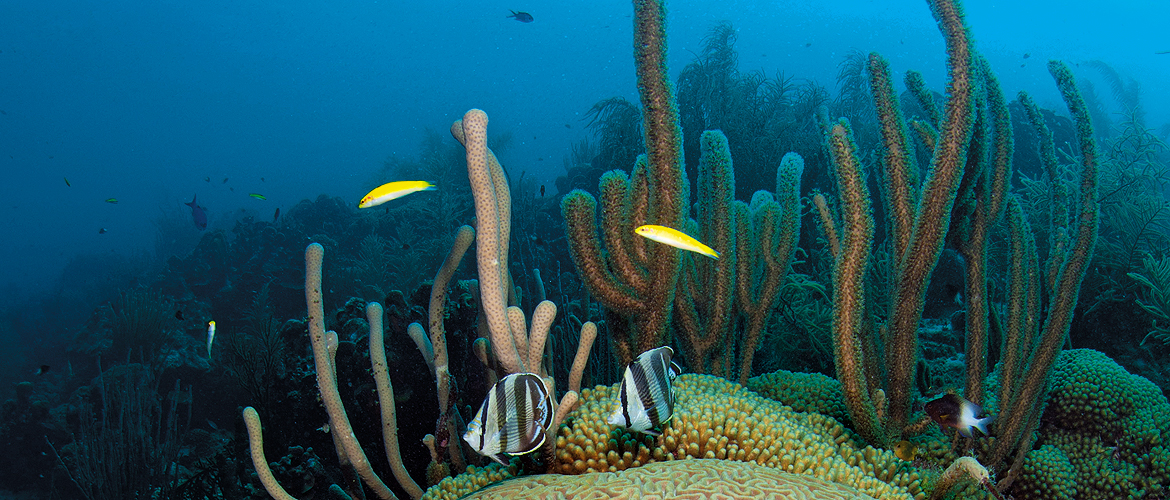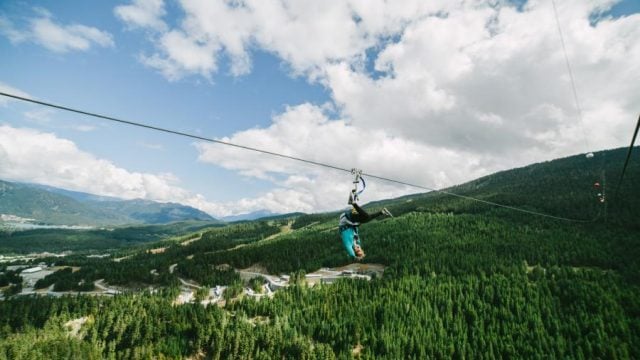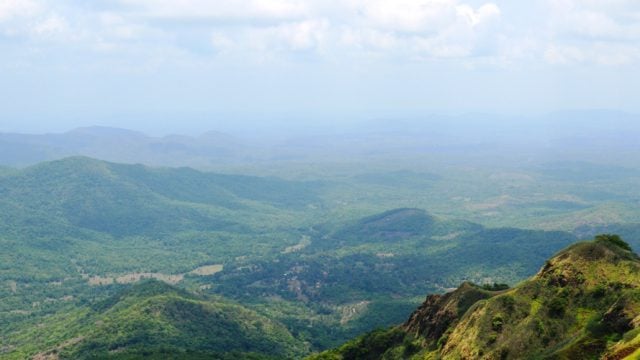“It is no problem, my friend. You just jump,” declares the snorkelling guide, gesticulating wildly towards the
I have flippered, cold feet. I am not sure if it’s the rocking of the anchored boat on the choppy waters that is making me giddy or his absurd suggestion. But I had, in an impulsive airport purchase, bought the latest GoPro especially for this underwater event and I have to make it look good. The tiny camera is at the ready, encased in its waterproof housing, stringed tightly around my right wrist.

“Are you going or what?” he says with a hint of irritation. I take the proffered ring buoy and descend into the Indian Ocean. Hanging on to that buoy for dear life with one hand, the other clinching the GoPro, I keep my head down for over an hour until the guide wriggles up with the creatures of the ocean and coerces me back aboard.
It isn’t as if I had not been surprised before in Africa. Five years ago, I had made an impulsive trip to Zanzibar from Tanzania with my fiancé. I had read about the archipelago’s ancient trade routes that ferried slaves and spices but no one had told me about the dazzling beaches, the centenarian giant tortoises and other marine life.
Indeed, when most people think of Africa and its wildlife, few think beyond the ‘Big Five’, or the marauding wildebeest and zebra herds. Africa as the place of pristine, soft-sand beaches and turquoise waters that hide incredible marine life, or Africa as a place of humanity’s very origin, is lost in the mad, touristy ticking-the-animals-off- the-list game. The continent’s spectacular terrestrial creatures overwhelm the senses and anything else is just a bonus.
Just a few days earlier, in Maasai Mara and Lewa Downs, we had had our moments with the Big Five in the brief drive to the airstrip. But there were no herds. It’s awful to visit the savannas when the herds are gone. It was late December and, having grazed up the Mara plains, the wildebeest and zebras had swept across to the wider expanse of the Serengeti.
And, as if to make up for the missing zebras, the Watamu reef below me bubbles with zebra fish, named for their black and white stripes. With every morsel of bread that the boatman chucks into the ocean—not recommended, since this interferes with the fishes’ regular feeding patterns—schools of zebra fish appear from nowhere to greedily gobble up the morsels.
The Indian Ocean, stretching from Southeast Asia to East Africa, is an astonishing cornucopia of marine life. Apparently, there hasn’t been adequate research on its array of species, many of which scientists believe still lie undiscovered and many that could simply be vanishing without documentation in the havoc caused by climate change.
Ocean currents circulate in labyrinthine coils across the expanse of the Indian Ocean. Therefore, any rubbish thrown off the Indian coast could wash up on the beaches of East Africa and vice versa.
“We have been doing some research. We haven’t so far got any rubbish from India but we have from Malaysia and Thailand. It’s really interesting how the currents work,” says Steve Trott, a marine zoologist and chairman of the Watamu Marine Association.

The reef I hover around mainly has boulder brain corals. These, as the name suggests, are brain-shaped with many tiny rifts, ridges and valleys in which tiny fish play hide and seek. Because of their slow growth and sturdy shape, they are relatively resistant to coral bleaching compared to the other delicate corals. Coral bleaching is a phenomenon triggered by global warming. Warm water forces the coral to expel the algae living on it. The corals then look white or bleached. The El Nino event in 1998 bleached almost 70 per cent of the coral in East Africa, save the boulder brain coral.

A visit to Watamu is incomplete without exploring Mida Creek, a 32 sq km tidal inlet that comprises a mangrove forest. A boardwalk takes you through this forest. But don’t expect the sort of polished, primed boardwalk you have at Sentosa in Singapore: here, wooden planks are strung together in a rough and ready way, many of them missing and others rotting. Some of the heavier members in our group worry about the planks crashing beneath them as they wobble along nervously.

At the end of the boardwalk is a bird-viewing platform from where one can feast one’s eyes on a host of migratory birds fleeing the European winter. Flamingos congregate in huge numbers in the vast mudflats fringing the creek. However, in the midday sun we see only a smattering of birds. “If you come one hour before high tide you can see a great aggregation of sea birds. They say it’s the largest aggregation of sea birds in East Africa. They number over 10,000. September to April is the best time to come. You just need to time the tide,” says John, our guide.
We descend to the mudflats and reach our dugout boats anchored in the shallows. The walk forms a fascinating 20-minute study in marine biology. Every now and then, John swoops down to dig out or point at an invertebrate. He scoops up a triangle-shaped organism. It’s a razorfish and, like most organisms here, it’s a mollusc with a razor-sharp shell.
“They say one square metre of this mudflat has the same energy as a full chocolate bar. I mean there are so many organisms living here,” John says, patting the loamy earth where we see nothing. But he scoops up the earth from right under and points to some squiggly, squirming organisms, exclaiming excitedly, “See, it’s so full of life. See!”
The dugout boat is made of the hollowed-out trunk of a baobab, a bottle-shaped tree that liberally dots the coast. You sit one behind the other in the narrow hold with the boatman rowing with a long pole behind you. And as our boats move, the boatmen sing.
There may yet be a lot to sing about in this part of Africa, comparatively serene and unpolluted. But it isn’t fully protected from the scourge of overdevelopment. Apart from climate change, the biggest danger to the marine biosphere in Watamu, as elsewhere, is overfishing. For example, the overfishing of predator fish and molluscs often leads to the proliferation of sea urchins here. The sea urchins then feed on sea grass unchecked. This destabilises the sea bed leading to more wave action. With no buffer, the waves erode the beaches. And so it goes.
Marine conservation organisations such as the Watamu Marine Association have stepped up to the challenge and, from waste management to recycling to educating fishermen, they are fighting to protect the unique marine biosphere of East Africa. Let us hope they succeed.
The Information
GETTING THERE
Kenya Airways has two flights daily to Nairobi from Mumbai (approx. â?¹ 31,000 round trip). Airlines such as Emirates and Ethiopian Air do the run with one stop. From Nairobi, one can take a Safarilink aircraft to Malindi. Watamu is approx. 20km from Malindi by road.
WHERE TO STAY
Watamu is just like any other beach town. All the crowded markets selling touristy bric-a-brac are inland, while the fancy resorts and hotels face the sea. At the top end is the Medina Palms, featuring an assortment of large apartments with Persian architectural elements and situated a stone’s throw from Watamu beach (from $242; medinapalms.com). The Charming Lonno Lodge gives it stiff competition (from $260; lonnolodge.com). More affordable but still chic are the Mawe Resort (from $100; maweresort.com) and Crystal Bay Resort (from $110; crystalbay watamu.com). Budget tourists will find the cosy Hossana Guesthouse welcoming (from $63; http:// bit.ly/2dcglxy), though it’s on the Watamu main road and a bit of a walk from the beach.
WHAT TO SEE & DO
Make a trip to Mida Creek. Visit the Bio-Ken Snake Farm (bio-ken.com). Spend a few hours at the Local Ocean Trust and witness their flagship Watamu Turtle Watch programme (watamturtles.com). Snorkel, scuba, paddleboat, swim, relax, laze.
Africa
Big Five
conservation





